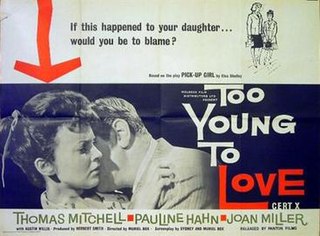Related Research Articles

Dame Dorothy Tutin was an English actress of stage, film and television. For her work in the theatre, she won two Olivier Awards and two Evening Standard Awards for Best Actress. She was made a CBE in 1967 and a Dame (DBE) in 2000.

Joan Mary Waller Greenwood was an English actress. Her husky voice, coupled with her slow, precise elocution, was her trademark. She played Sibella in the 1949 film Kind Hearts and Coronets, and also appeared in The Man in the White Suit, Young Wives' Tale, The Importance of Being Earnest (1952), Stage Struck (1958), Tom Jones (1963) and Little Dorrit (1987).

Billie Honor Whitelaw was an English actress. She worked in close collaboration with Irish playwright Samuel Beckett for 25 years and was regarded as one of the foremost interpreters of his works. She was also known for her portrayal of Mrs. Baylock, the demonic nanny in the 1976 horror film The Omen.

Sylvia May Laura Syms was an English stage and screen actress. Her best-known film roles include My Teenage Daughter (1956), Woman in a Dressing Gown (1957), for which she was nominated for a BAFTA Award, Ice Cold in Alex (1958), No Trees in the Street (1959), Victim (1961) and The Tamarind Seed (1974).

Francis Finlay, was an English actor. He earned an Academy Award nomination for his performance as Iago in Othello (1965). His first leading television role came in 1971 in Casanova. This led to appearances on The Morecambe and Wise Show. He also appeared in the drama Bouquet of Barbed Wire.

Moira Redmond was an English actress.

Ronald Glasfryn Lewis was a Welsh actor, best known for his appearances in British films of the 1950s and 1960s.
Peter Cotes was an English director, producer, actor, writer and production manager.

Too Young to Love is a 1959 British drama film set in New York. It was directed by Muriel Box and starring Pauline Hahn, Joan Miller, and Austin Willis. It was based on the play Pickup Girl by Elsa Shelley. An adaptation of the story was broadcast on British TV on 6 December 1957 in the ITV Television Playhouse series.
The One Day of the Year is a 1958 Australian play by Alan Seymour about contested attitudes to Anzac Day.
Ending It was a 1939 BBC TV one-off play, written by Val Gielgud, and starring John Robinson, Joan Marion, and Dino Galvani. It was 30 minutes in duration. It was broadcast live on 25 August 1939.
"The Scent of Fear" is television play written by Ted Willis. It was originally written for British anthology series Armchair Theatre, adapted from the story "Stowaway" by Mary Higgins Clark which was reportedly based on a real story that happened in 1949. It was filmed for Australian TV in 1960.
The General Motors Hour was an Australian radio and television drama series.
"Long Distance" is a 1961 Australian television film. It was based on a 1948 American radio play, and retained the U.S. setting. It was among the first local drama productions by station HSV-7, and aired in a 30-minute time-slot. It was telecast on 8 June. An excerpt from it appeared in a 2006 documentary called Studio One, suggesting Long Distance still exists despite the wiping of the era. The film was produced by British producer Peter Cotes and starred his wife, Joan Miller. It was recorded in March 1961 but its air date was pushed back to 8 June 1961, due to a talk by the Prime Minister. It was the only one of Cotes' Australian productions to air while he was in Australia; the others were not screened until the following year.

Corinth House is a 1961 Australian TV movie based on the play by Pamela Hansford Johnson and directed by Bill Bain. It was sold overseas.

Fury in Petticoats is a 1962 television play broadcast by the Australian Broadcasting Corporation. It was directed by Christopher Muir. It was based on a play which had been filmed by British TV the year before.

Frederick Henry Parslow was an Australian actor, who appeared in film, television and theatre.

The Lark is a 1958 Australian TV version of the 1952 Jean Anouilh play of the same title.
"Candida" is a 1962 Australian television play.
"Shadow of the Vine" is a 1962 Australian television play adapted from a 1949 play by Beverley Nichols. It aired on 7 October 1962 in Sydney and Melbourne, and on 3 June 1962 in Brisbane and Adelaide.
References
- ↑ "Peter Cotes Drama Out of Storage". The Age. 31 May 1962. p. 8.
- ↑ Marshall, Valda (3 June 1962). "TV Merry Go Round". Sydney Morning Herald. p. 58.
- ↑ "Television for 1962" (PDF). GMH People. May 1962. p. 7.
- ↑ "Fear". The Age. 31 May 1961. p. 7.
- ↑ Vagg, Stephen (18 February 2019). "60 Australian TV Plays of the 1950s & '60s". Filmink.
- ↑ 1948 US TV Version at IMDb
- ↑ 1952 US TV Version at IMDb
- ↑ 1939 British TV version at IMDb
- ↑ 1946 British TV version at IMDb
- ↑ 1958 British TV version at IMDb
- ↑ "Credit Squeeze Hits Plans for Drama". The Age. 20 July 1961. p. 11.
- ↑ "Peter Cotes Drama Out of Storage". The Age. 31 May 1962. p. 8.
- ↑ Roberts, Frank (16 June 1962). "LOOK HOMEWARD PIGEON". The Bulletin. p. 56.
- ↑ "Joan Miller Outstanding". The Age. 7 June 1962. p. 13.